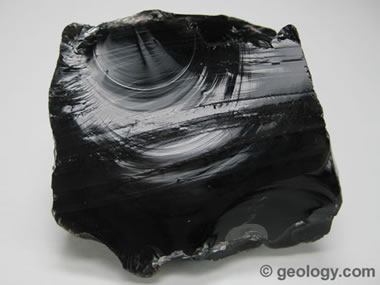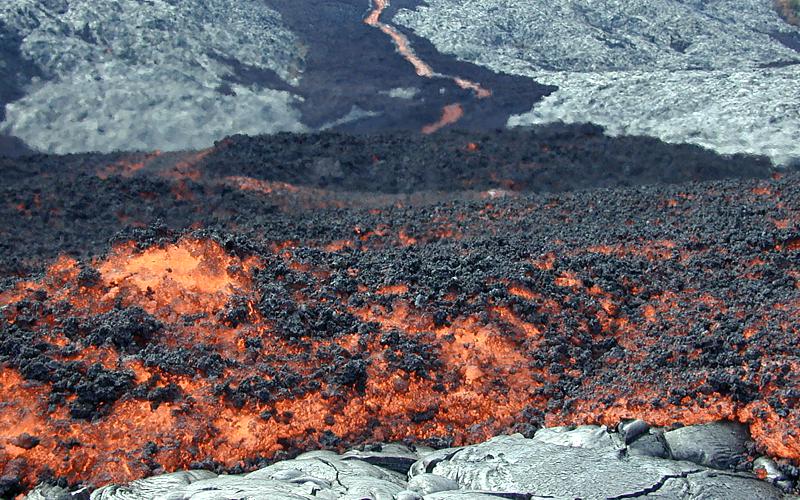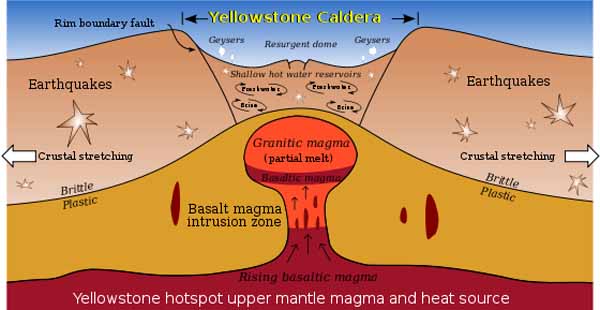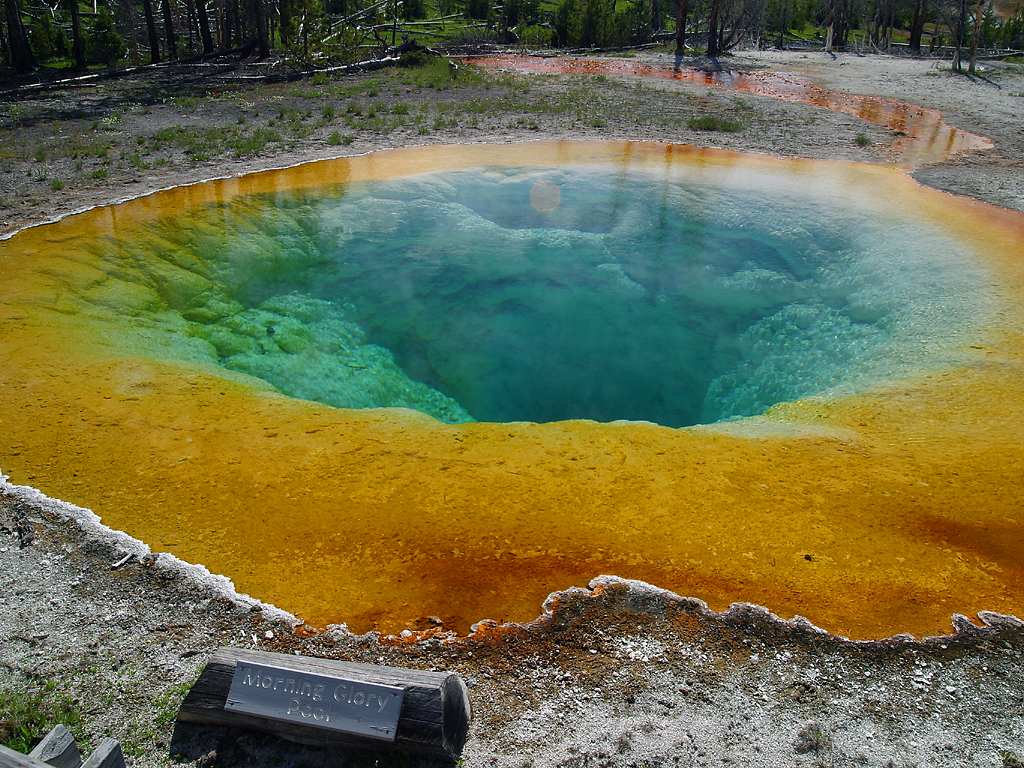In class, we learned about many of these topics. To aid is in learning about the many rocks that come from volcanoes, we did a lab on different kinds of rocks. We described and sketched each different rock around the room, and inferred about the viscosity, temperature, and explosion type. Using a chart about different volcanoes and the properties of rocks that come from them, we could also guess what kind of volcano the rocks came from.
A shield volcano is an area where lava flows from quiet eruptions, gradually building up a mountain. These are broad mountains, increasing in height over a long distance. These volcanoes form on hotspots in the mantle, where hotter lava rises and burns through the crust. A shield volcano you'll find in the real world is Mauna Loa, which makes up one of the islands of Hawaii.
(http://rhynotnt64.webs.com/Mauna%20Loa.jpg)
Next up is cinder cone. These volcanoes form from cinders erupting from a volcanic vent, piling up around it. This forms a cone shaped hill, a cinder volcano. These volcanoes have explosive eruptions, and the lava coming out isn't as hot.
(http://volcanoes.usgs.gov/Imgs/Jpg/Photoglossary/30424305-084_med.JPG)
Finally, there are composite volcanoes. These have alternating layers of ash, cinders, bombs, and lava flows. They erupt both quietly and explosively. They are tall and cone shaped. A famous example of a composite volcano is Mt. St. Helens in Washington.
(http://upload.wikimedia.org/wikipedia/commons/thumb/8/8c/Sthelens1.jpg/300px-Sthelens1.jpg)
There are also rift or fissure eruptions. These are eruptions that happen when two tectonic plates are spreading apart. When they pull apart, cracks form in between them. Magma erupts through the cracks onto the surface.
(http://wisconsingeologicalsurvey.org/geology/images/continental_rift.jpg)
This is a fissure eruption captured on video.
Pillow basalts are rocks that have erupted that have a distinct pillow shape. They usually form underwater. The contact of the lava and water forms the shape. They vary and can be up to several meters in size.
(http://upload.wikimedia.org/wikipedia/commons/0/08/Pillow_basalt_crop_l.jpg)
This is a video of pillow basalts forming underwater.
There are also other types of rocks such as columnar basalts, obsidian, bombs, and pumice.
Columnar basalts form from thick lava flows cooling quickly. When they cool, they form contraction forces, and the lava starts to flow vertically down. The flow forms rocks that look like columns, when flowing downwards.
(http://upload.wikimedia.org/wikipedia/commons/e/e7/Boyabat.jpg)
Pumice is very vesicular, which is why there are so many holes in the rock. It forms when highly pressured rock comes out of an explosive volcano. It was under high pressure before, but as it comes out it depressurizes. This combined with the cooling of the rock forms the bubbles and the rock, Pumice.
(http://geology.com/rocks/pictures/pumice.jpg)
Bombs are round shaped rocks that also form from explosive eruptions. When a blob of lava erupts out of a volcano. As they fall down, the blob begins to cool into a rock. They are cooled as they fall to the ground as bombs. There are many variants of bombs. The different variants are related to how these blobs fall.
(http://upload.wikimedia.org/wikipedia/commons/8/88/VolcanicBombMojaveDesert.JPG)
Obsidian is an glassy rock formed from the rapid cooling of thick lava with high silica content. When this lava flows, if it cools rapidly, obsidian will form. There are no crystals in obsidian.
(http://geology.com/rocks/pictures/obsidian-380.jpg)
These rocks come from either explosive or quiet eruptions, but you may wonder, why are some eruptions explosive and why are some quiet? It's connected with the viscosity of the magma. When magma is more viscous there is more silica, and it is a higher temperature. At shield volcanoes such as in the Hawaiian Islands, there is low silica content, so the lava erupting is much more "runny" and thin. When there is higher silica content, the pressure needed for the volcano to erupt is greater, because of its thickness. Shield volcanoes tend to have lower silica content because of the temperature of the magma. It only rises and burns through the crust because of its heat. Other volcanoes mostly form near subduction zones, where the lava is cooler and has a higher silica content. These composite and cinder-cone volcanoes will have more explosive eruptions.
Aa and Pahoehoe are two types of rocks formed by quiet eruptions. Although the eruption is quiet, it still forms different rocks, and they can also come from the same volcano. Pahoehoe is fast moving hot lava before it cools. As it cools it looks like rope or wrinkles. Aa is formed from slower moving cooler lava. When Aa cools, it looks very jagged and rough. The temperature of the lava determined the different kinds of rocks created when cooled.
Aa
(http://www.geokem.com/images/scans/Hawaii-Aa.jpg)
Pahoehoe
(http://www.livingwilderness.com/hawaii/hawaii-pahoehoe-flow.jpg)
Yellowstone National Park has the worlds most diverse collection of geothermal features in the world. These mudpots, fumaroles, hot springs, and geysers didn't just randomly choose to all form in one area though, there is a reason for it. Yellowstone is located right on top of a hotspot. This is an area where extremely hot magma rises through the mantle to burn through the crust. Because of the magma underneath Yellowstone, when water from rain or snow melt seeps into the ground, it may pick up minerals and be heated from below. The different physical features of the ground, and the amount of water create one of the four geothermal features.
(http://www.virtualuppermantle.info/images1/Yellowstone/600px_Diagram-Yellowstone_Caldera.jpg)
These four features are similar in many ways but there are key differences that define them.
When thinking of a geyser, picture an upside down ice cream cone in the ground. It has a small opening at the top, and is wider at the bottom. When water seeps down into one of these areas, it gets heated at the bottom. As it gets heated more and more, it begins to build up pressure. When enough pressure builds up, it will release at through the top and spew out water everywhere.
(http://www.youtube.com/watch?v=LWrklFuYnb0)
Fumaroles and geysers aren't very different. They have the same overall structure but the key difference is that in fumaroles, there is less water. When the water that is there is heated, it becomes too hot and turns into steam, and the steam emits from the opening.
(http://www.youtube.com/watch?v=lYCtUfKkRJs)
Hot springs aren't too far from those two either. The difference with this feature is that the opening isn't small, it's wide. The wider opening doesn't allow pressure to build up, so the water that is in a hot spring just ends up being heated.
(http://whatsup.lixlink.com/wp-content/uploads/2008/06/morning_glory_pool.jpg)
Finally, we have mud pots. These form when rain or melt water mix with clay being heated by the rocks underneath them. When these two mix, they will create mud. The mud is still sitting on top of the rocks being heated by the magma, so the mud pots will bubble.
(http://castle.eiu.edu/~wow/classes/fa09/Yellowstone/yel_mudpot.jpg)













No comments:
Post a Comment
Note: Only a member of this blog may post a comment.